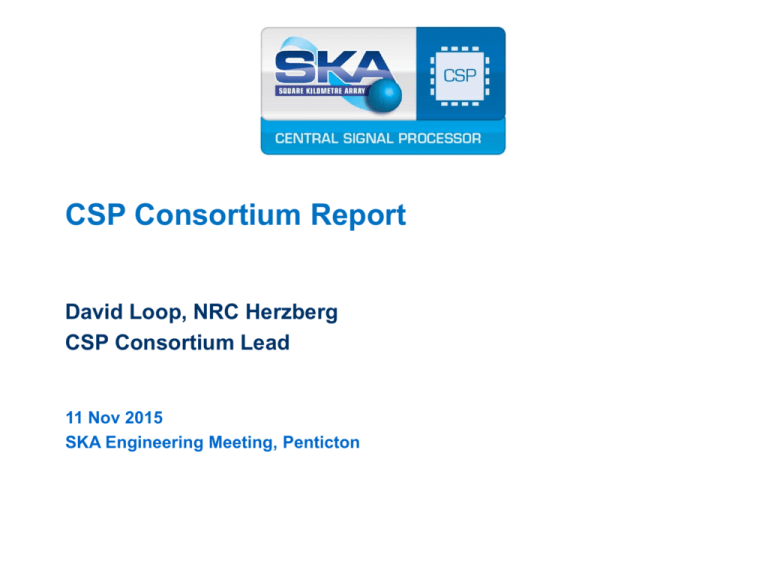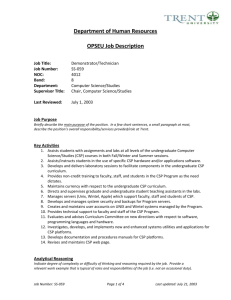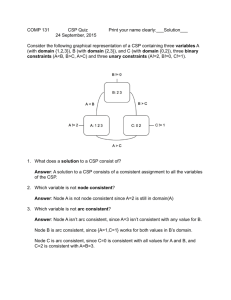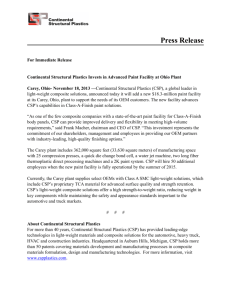151111_0930_Central_Signal_Processor_
advertisement

CSP Consortium Report David Loop, NRC Herzberg CSP Consortium Lead 11 Nov 2015 SKA Engineering Meeting, Penticton CSP Consortium 1 CSP Work Package • • Carry Central Signal Processing Design to CDR A horizontal slice across both Telescopes – SKA-Low, SKA-Mid Strengths • • • • “combined view” to explore domain commonalities/synergies Building from prior experiences on EVLA, MWA, LOFAR, ASKAP, MeerKAT, Pulsar Search Weaknesses • • • Requirements dealt with in isolation, long list of assumptions Relies on strong external interface definitions Relies on Telescope Architecture Teams CSP Consortium 2 CSP Consortium Participants 14 signatories 9 countries 20.7 M€ 130 FTE-yrs CSP Consortium Canada • NRC (Lead) • MDA • CITA Australia • CSIRO • Swinburne • ICRAR • NVIDIA • CISCO New Zealand • AUT • Compucon • Open Parallel • U of Auckland • Massey U • Nyriad JPL (US) IBM (Switzerland) Netherlands • ASTRON • JIVE • NLeSC UK • Manchester • STFC • U of Oxford Italy • INAF • Selex ES India • NCRA • NVIDIA Germany • Max Planck IfR Spain • UPMadrid 3 CSP Organization Structure CSP Consortium 4 CSP Product Breakdown Structure CSP Consortium 5 CSP Architecture to Level 3 Low.CBF (Correlator Beamformer) Grant Hampson, CSIRO - FPGA o Peter Hall, ICRAR – Software COTS CPU/GPU/Infiniband Mid.CBF (Correlator Beamformer) Brent Carlson, NRC Herzberg – FPGA PowerMX PSS-Low/Mid (Pulsar Search Engine) Ben Stappers, Manchester – COTS CPU w/GPU and/or FPGA accelerators PST-Low/Mid (Pulsar Timing Engine) Willem van Straten, Swinburne – Software COTS GPU/CPU/switch LMC-Low/Mid (Local Monitoring and Control) Sonja Vrcic, NRC Herzberg – COTS CPU CSP Consortium 6 Low CBF Progress LOW Rebaselining • Before rebaselining large but simple correlator • Rebaselining has reduced the number of stations from 1024 to 512, but added Multiple Zoom modes Pulsar Search beams Pulsar Timing beams Different in every subarray • Major system redesign required CSP Reorganisation • Loss of Survey correlator completely changed the allocation of work packages • New Low.CBF collaboration was formed – made great progress after 5-months CSP Consortium 7 LOW CBF Collaboration Formed ASTRON, Curtin CSIRO Strong and NZA united team! CSP Consortium 8 LOW CBF Approach The collaboration is approaching the design in a genuine, open-minded and consultative manner • Everyone gets the opportunity to be heard Three significant meetings: • July 2015: Edinburgh – Planning • • Collaboration meets for the first time, understanding approaches Sep 2015: San Francisco – Kickoff / Icebreaker • • Engineers meet and options tabled Nov 2015: Sydney – Downselect • • All major design decisions made – foundations set Commenced writing documentation for Delta-PDR submisssion for end-Jan’16 CSP Consortium 9 LOW.CBF System Signal Processing Algorithms • RFI excision, delays using phase shifts, beamformers, correlator zooms using fine channel accumulation • Matlab/Simulink modelling progressing Hardware solution • Liquid cooled “pizza” box – standard LRU • One FPGA per board – rapid development and path to production • All optical interconnect – fully flexible system configuration/size Firmware solution • Technology independent design flow for all firmware except processing functions are optimized to the FPGA • Focus on Xilinx FPGAs towards CDR • Monitor and Control FW/SW solution Management and System Engineering • Resources and objectives for CDR are achievable CSP Consortium 10 Low SW Verification Correlator ICRAR/Curtin led effort to support early verification of the LFAA NVIDIA in-kind contribution ~0.5 FTE. AUS pre-construction funding ~0.5 FTE. Cisco are supplying extensive benchmarking hardware. Investigating CSP processing in Perth Curtin awarded a Shared University Research Grant for IBM to support SKA and MWA Software Correlator Development CSP Consortium 11 1 Mid.CBF Contributors • NRC (HW,FW,SW) • MDA (PM,PE,SE,FW) • NZ Alliance (FW,models) • Selex (HW) • UPM (FW) • INAF/Italian Industry (HW,FW) CSP Consortium 12 Mid.CBF Downselections in 2015 SKARAB Redback Arch A Blade/ Backplane vs Arch B PizzaBox CSP Consortium PowerMX Baseline: Arch B PowerMX in Pizza Box with optical interconnect Air-cooled (tbc) 13 Mid.CBF Signal Flow CSP Consortium 14 Mid.CBF Prototyping Plans • • Develop PowerMX SX4-1 motherboard Develop PowerMX mezzanine cards • • • Verify critical design functionality/performance • • • • • • First mezzanine card with available Arria 10 FPGA Later mezzanine cards with Stratix 10 FPGAs Motherboard/mezzanine communication and control (Arria 10) HMC memory access and performance (Arria 10) SERDES communication at 25/28G (Stratix 10) Develop test firmware and software to support above activities Develop DSP Firmware to ensure processing will fit within selected FPGA devices Develop thermal mockups to test cooling solutions CSP Consortium 15 Pulsar Search: PSS-Low/Mid – Personnel Manchester, Oxford, MPIfR, STFC, ASTRON, INAF, NZA, Swinburne Progress Acceleration Search: Near complete GPU based implementation, ~50% complete FPGA implementation Single Pulse Search: Near complete GPU and FPGA based implementations Pipeline: Majority of aspects of framework in place – connection with individual modules on accelerators underway. Hardware: New FPGA and GPU hardware in the New Year, also 5% prototype (see later). Industry: Strong Hardware links established and extended, recently begun working with specialist FPGA developers. SKA1-LOW: Progressing ICDs – PSS design predominantly unchanged CSP Consortium 16 PSS-Low/Mid – Addressing Power • Need to achieve a Gflops/Watt 5 times better than current greenest computer. • Three pronged approach: Algorithms Pursue innovative approaches to cut processing times CSP Consortium Hardware Testing In situ while running Not only looking at accelerators using custom sensor hardware 17 but hosts and storage. PSS-Low/Mid – Prototyping Plans • Emphasis on power! • Vertical prototyping: • Advance processing modules to TRL6 and TRL7 • Horizontal prototyping: • Advance pipelines (receptors + host-to-device interfaces to TRL6 and TRL7 • Target technologies: • Undergoing down-selection process • FPGA, GPU + host CPU remain strongest candidates New development: ProtoNIP • Fully funded (UK) PSS prototype to be installed on the SKA-SA site. • ~20 PSS nodes and switches based on the PSS PIP architecture • Designed to test density, power consumption, heat dissipation in the real PSS environment. • Test reliability and maintainability of potential PSS cluster components. • Test data persistence, movement and management in PSS software. • Test logistical assumptions for PSS, further mitigate cost uncertainties. • ProtoNIP will be installed on-site by 2016 Q3, and used to inform PSS CDR. CSP Consortium 18 Pulsar Timing: PST-Low/Mid • Designed at Swinburne University of Technology • Expanded to SKA1-Low • Performs phase-coherent dispersion removal CSP Consortium 19 PST-Low/Mid Baseline Solution • 16 phased array beams on Low and Mid • • 16 servers, each with 4 GPUs Space: 2 racks; power: 18 kW • Compliant for Mid, not for Low • • maximum dispersion measure currently too high revisions under consideration by Pulsar SWG • Prototyping plans • • testing prototype at SKA-SA in Nov 2015 Commissioning at MeerKAT in Q1 2016 CSP Consortium 20 PST CSP Consortium 21 CSP LMC - Local Monitor and Control Contributing Organizations NRC, Canada NCRA, India INAF, Italy University of Swinburne, Australia CSP Consortium 22 CSP.LMC - Overview • Reports on behalf of CSP • Co-ordinates Pulsar Search and Pulsar Timing observations CSP_Low.LMC CSP_Low.CBF CSP_Low.PSS Pulsar Search CSP_Low.PST Pulsar Timing CSP Consortium 23 CSP LMC – Technical Solution • Software running on COTS computer. • Uses TANGO CS for communication with TM and other CSP sub-elements (CBF, PSS and PST). • INAF is working on TANGO based prototype. • The same technology used in CSP_Low and CSP_Mid. CSP Consortium 24 Schedule CSP Consortium 11 Delta PDR Jan-16 11a System PDR Inputs Dec-15 12 Technical Interchange Meeting #5 Mar-15 12a Pre-CDR 13 Sub-element CDRs & Prototype Test Reports 30-Sep-16 13a Pulsar Timing Sub-element (Formal Review) 30-Sep-16 13b Pulsar Search Sub-element 28-Nov-16 13c Mid CBF & LMC Sub-elements 13d Low CBF Sub-element 5-Dec-16 12-Dec-16 14 Submission of Stage 2 (CDR) Data Package 23-Jan-17 15 Review of Stage 2 Data Package (CDR) 20-Mar-17 16 Closure of Stage 2 28-Apr-17 17 Submission of the final documentation package for supply of the Element. 28-Apr-17 25 Progress Against Plan • PDR – a few remaining OARs and Low.CBF “update” due to team/solution change • TIM#4 – certificate in process • Delta PDR – some remaining documents considering RBS and latest downselections • System PDR inputs – most in signature cycle CSP Consortium 26 Current State of CSP Design • Level 1 (Parent) req’ts for CSP: 6B • Still tracking large number of issues/assumptions Level 2 CSP Req’ts: Rev 1 • • Proceeding making documented assumptions Level 2 CSP Architecture: 100% External ICDs: 90% Getting attention, must close asap CSP Consortium 27 Current State of CSP Design cont’d • Internal ICDs for CSP (between sub-elements): 80% • Level 3 Req’ts (sub-elements): 50% • • Keeping pace with design work Being upgraded to RBS Level 3 Architecture: ~ 70% Level 3 Physical Solutions: good progress CSP Consortium 28 Challenges and Issues Costing increases • Re-baselining has added significant complexity • Open tender procurement model • 2018 technology freeze date Power budgets • Challenging targets to meet with increased complexity CSP Consortium 29 Challenges and Issues Technical issues • RFI (environment; number of bits) • Calibration issues (tied-array beam placement; fidelity issues; approaches; update rates) • Transient buffer & response • Clock offset scheme CSP Consortium 30 Summary • • • • • • • Messy down select process behind us Good progress by all the teams Big push now to get to CDR Remaining system issues need to be resolved Requirements assumptions starting to harden Construction costs are challenging Power budgets are challenging CSP Consortium 31







